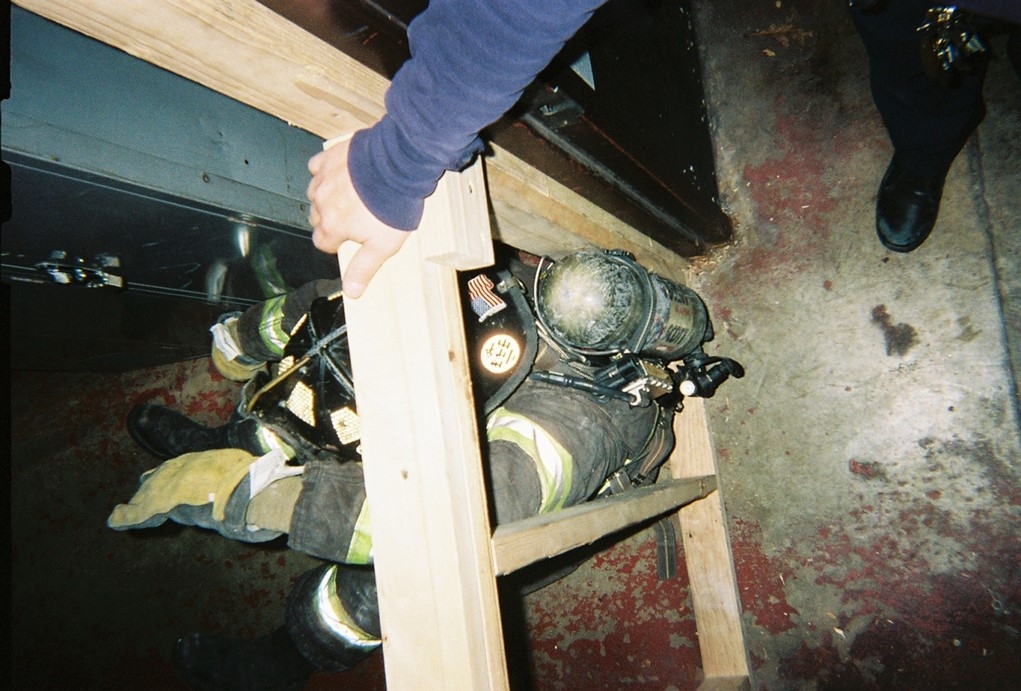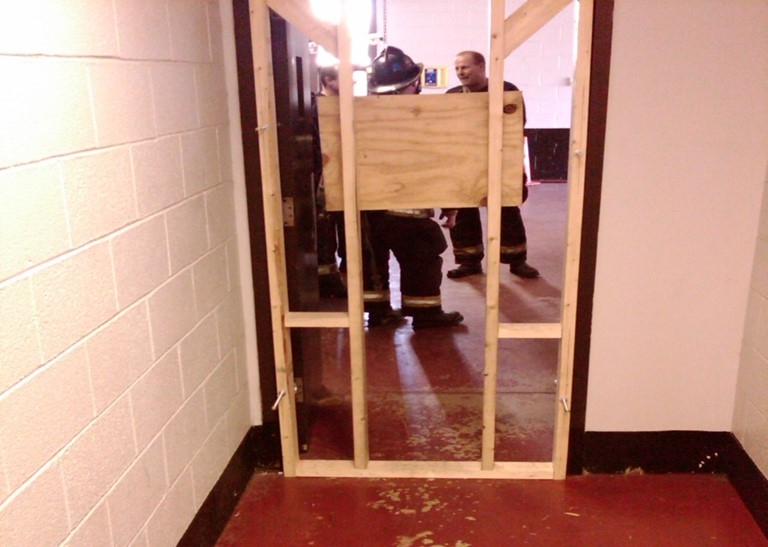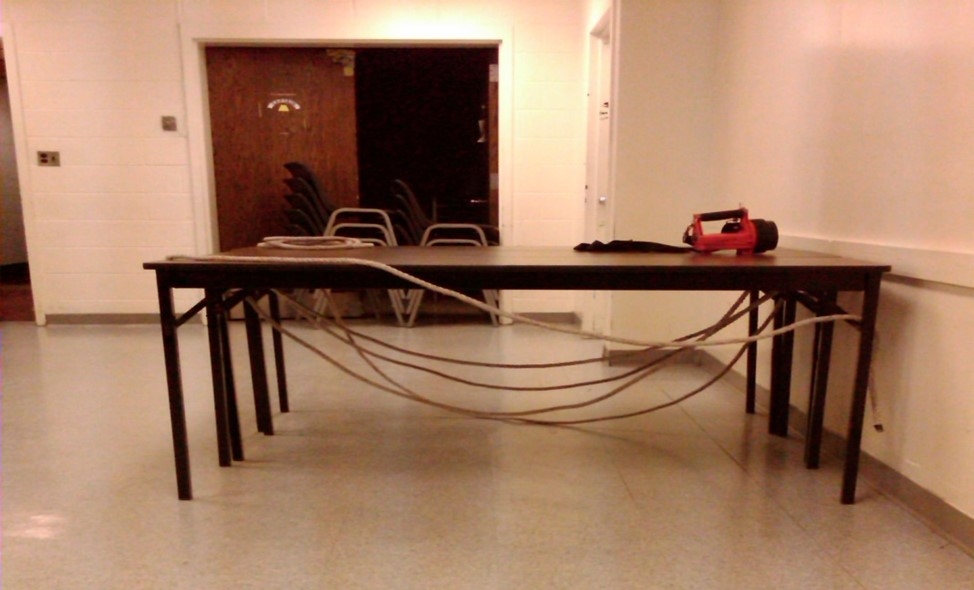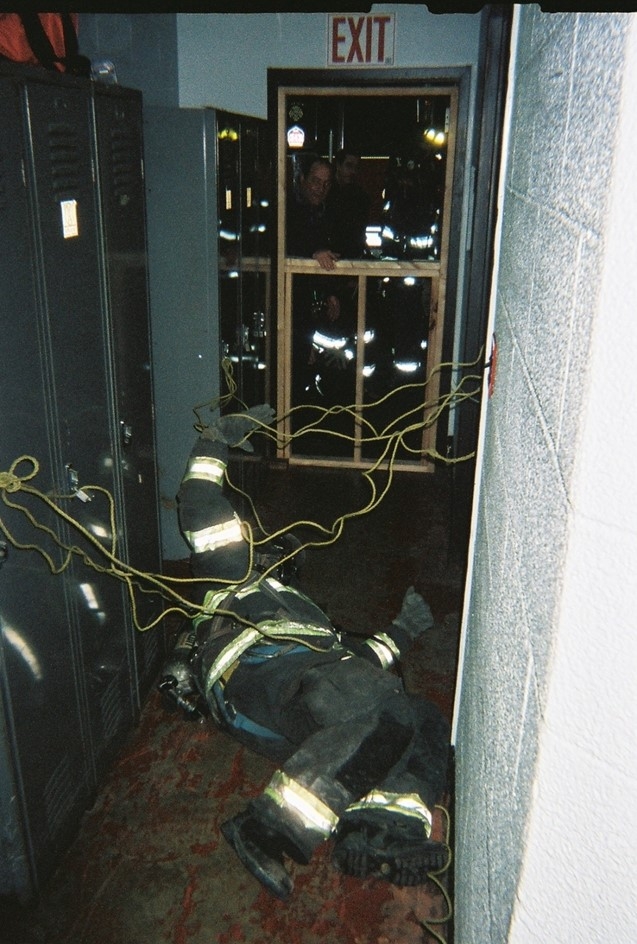Full Contact Training with Chief Avillo
Effective Survival Training – Putting on the Pressure
It is critical that firefighters be taught and understand basic survival tactics and skills. Successfully negotiating entanglements is one of those skills. Negotiating a reduced clearance area is another. Doing it in the friendly atmosphere of the “usual” training session is one thing. Doing it under pressure in reduced visibility is quite another, even when it is in training. If they cannot do it under pressure, then they cannot do it and need further training.

The Detroit Dive is the easiest of the reduced clearance maneuvers. It must be practiced and done in proper sequence. Some also call this the “swim technique” or the “through the studs” technique. (Photo by author)
Most firefighters are relatively well-skilled in both the reduced profile and Detroit dive maneuvers. They are less skilled at negotiating wire entanglements. We observed this first-hand at the FDIC (Fire Department Instructor’s Conference), between 1999 and 2009, where I had the privilege of teaching the H.O.T. Truck Company Search Operations class. When we and they demonstrated these skills before entering the mask confidence course, most were rather good at it. Once we hooded them, played demonic music at ear-splitting volume, and pestered and harassed them throughout the course, their skills broke down. What we had done was put them under pressure. Their skills failed them because they had not been trained with that level of intensity. Unfortunately, this often carries over to the fireground. Chances of being able to complete these skills on the fireground when they could not be done properly under pressurized training conditions is nil at best. If you, as an officer, are conducting these type company drills in the casual climate of the kitchen with the TV on, you might as well keep watching TV. Casual training leads to causal skills which lead to casual firefighting. There can be no such thing as casual firefighting.
At the FDIC, whenever someone did not successfully negotiate a prop in the course, we considered he or she had been killed there and had them put a plastic knife in the aptly named “boneyard”, a makeshift cemetery we set up to commemorate the “dead”.

This is a picture the “boneyard” at the end of the first day of training. We trained approximately 160 firefighters over two days. Each knife in the boneyard represents one firefighter who would not have made it out. (photo by author)
In North Hudson, using the lessons learned at the FDIC, we put together a simple drill with easy-to-make and use props. The goal of any drill is to ensure success. Understand that you may have to do the drill more than once to achieve this. That is OK. The objective is to make progress each time the evolution is performed until the skill is learned and can be done with confidence – under pressure. Confidence is the key to success in these type drills. In order to gain confidence, it is important to build from the easy to the tough. Teach the skill, ensure the skill has been learned, and then apply a little pressure to give the skill some realistic application.
What we did to begin the march toward success was to build both a reduced clearance prop and an entanglement hazard. The reduced clearance prop simulated a standard (16” on center) wall stud prop, shown below. This was simply made with a bunch of 2” x 4”‘s built together to simulate wall studs. It can fit in any door. U-Brackets with butterfly screws on top and bottom of each side ensure a snug fit in any doorway.

(Photo by author)
The entanglement hazard is even easier. Take a few folding tables, put them together, and string some rope under them so it hangs low in the center. We arranged these into a course that took the members through one entanglement hazard, through the doorway with the reduced clearance, around the room through two more folding table entanglement hazards and back through the same reduced clearance to get out. You don’t have to create a sophisticated course if you do not have the room. This layout will work just fine and allow you to meet your objectives of instilling confidence and success.

What is simpler than this for an entanglement hazard? You don’t need sophistication; you just need something that will produce results. (Photo by author)

Here a firefighter negotiates an entanglement hazard created by tying rope off on some lockers. The reduced clearance prop is in the background. Notice the positioning of the body and the SCBA cylinder in relation to the “wires.” Get the bottle in the corner and use the upper arm, leading with the back of the hand, to create space between yourself and the obstacle, swimming under the wires. If the head comes up, the bottle comes up. Stay down!! (Photo by author)
To best instill confidence and still teach for success, we conducted the evolution over the course of several shifts. First, we explained the process we were going to use to build the skills and what was required to reach the goal – set the expectations first!!! Next, we showed the skills to the members in both the reduced clearance and obstacle hazard negotiation. Then, we let the members go through the course with only turnout gear and SCBA on (but not on air) in order to ensure the skills were being mastered. The lights were on and we coached those who were having a hard time.
The following tour in, we did the drill again and turned off the lights in the room. Although it was not pitch black in the room, the darkness added a little more pressure to the drill. We also put on the sound system in the room and put it between radio stations to sound like chaos (dispatch recordings work well here too, especially those with a lot of radio traffic). This time the members were on air.
Finally, for the last evolution, on the third tour, we had each member go through the course with obscured visibility. This was accomplished by pulling the hood over the facemask. Again, the members were on air and this time we turned the radio chaos up even louder. We found most members were confident enough at this point to successfully negotiate the course. The chances of that happening at this point would have been much less had we begun the drill with the conditions as they were in the third evolution. As we built in confidence, putting a little more pressure and challenge into each subsequent evolution, the ability of the members to carry out the evolution properly were significantly increased. To further test our theory of “success through repetition”, we allowed members who had been off on the first or second day to take part in the course as it was being presented that day. We also had some members from other shifts who were on mutual swaps that were boasting their prowess also negotiate the course. As expected, most could not do it as well as the ones who had started from the ground floor so to speak on the first day, further evidence of repetition and reinforcement building confidence and skill.
All these skill and confidence-building activities culminated in a bigger drill. We then took the skills “outside” to a playground where we simulated a mask confidence course. On this day, firefighters followed a hoseline though the multiple entanglement and reduced clearance hazards in the playground. We got this drill off YouTube under “the Playground Drill.” Check it out. It is a pretty cool way to create a mask confidence course without any cost to the department. The members were hooded and just about all did a great job. Those conducting and participating in the drill all agreed that the simple to complex method of learning these skills, more importantly under pressure, was the key to their success on the playground.
The sequence of battle-ready success is shown in the slide below:
